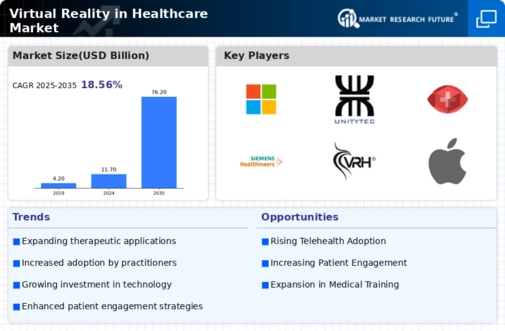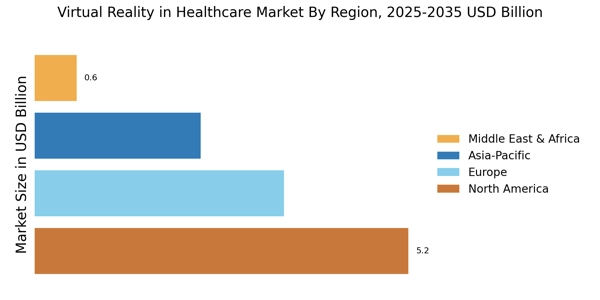Advancements in VR Technology
Technological advancements in virtual reality hardware and software are propelling the Virtual Reality in Healthcare Market forward. Innovations such as improved graphics, haptic feedback, and more intuitive user interfaces are enhancing the realism and effectiveness of VR applications in medical training and patient treatment. For instance, the development of lightweight VR headsets and mobile VR solutions has made it easier for healthcare professionals to incorporate these tools into their practices. Market data suggests that the VR hardware segment is expected to grow significantly, with projections indicating a compound annual growth rate of over 30% through the next few years. This technological evolution not only enhances the user experience but also expands the potential applications of virtual reality in various healthcare settings.
Growing Focus on Mental Health
The increasing awareness and focus on mental health issues are driving the demand for innovative therapeutic solutions, including those offered by the Virtual Reality in Healthcare Market. Virtual reality has emerged as a promising tool for treating conditions such as anxiety, PTSD, and phobias through exposure therapy and immersive experiences. Research indicates that VR therapy can lead to significant improvements in patient outcomes, making it an attractive option for mental health professionals. The mental health market is projected to reach USD 537 billion by 2030, suggesting a substantial opportunity for virtual reality applications to play a pivotal role in therapeutic interventions. As mental health continues to gain prominence, the integration of VR into treatment protocols may become increasingly common.
Regulatory Support and Funding
Regulatory bodies and government initiatives are increasingly recognizing the potential of virtual reality technologies in healthcare, providing support and funding to foster innovation within the Virtual Reality in Healthcare Market. Various grants and funding programs are being established to encourage research and development of VR applications in medical training, rehabilitation, and patient care. This support not only accelerates the development of new technologies but also enhances the credibility of VR solutions among healthcare providers. Furthermore, as regulations evolve to accommodate these technologies, the market is likely to witness a surge in adoption rates. The proactive stance of regulatory agencies could significantly influence the growth trajectory of the virtual reality sector in healthcare.
Increased Adoption of Telemedicine
The rise of telemedicine has catalyzed the integration of Virtual Reality in Healthcare Market. As healthcare providers increasingly adopt remote consultation methods, the demand for immersive technologies that enhance patient engagement and education has surged. Virtual reality applications can simulate real-life scenarios, allowing patients to experience procedures or therapies in a controlled environment. This not only alleviates anxiety but also improves understanding of treatment plans. According to recent data, the telemedicine market is projected to reach USD 459.8 billion by 2030, indicating a substantial opportunity for virtual reality solutions to complement these services. The synergy between telemedicine and virtual reality could redefine patient interactions, making healthcare more accessible and effective.
Rising Demand for Personalized Medicine
The shift towards personalized medicine is influencing the Virtual Reality in Healthcare Market by creating a need for tailored treatment approaches. Virtual reality can facilitate personalized therapy by allowing healthcare providers to create customized simulations that cater to individual patient needs. This adaptability enhances patient engagement and compliance, as individuals can visualize their treatment journey in a more relatable manner. Market trends indicate that the personalized medicine market is expected to reach USD 2.5 trillion by 2028, highlighting the potential for virtual reality to play a crucial role in this transformation. As healthcare continues to evolve towards more individualized care, the integration of VR technologies may become essential in delivering effective and patient-centered solutions.


















Leave a Comment